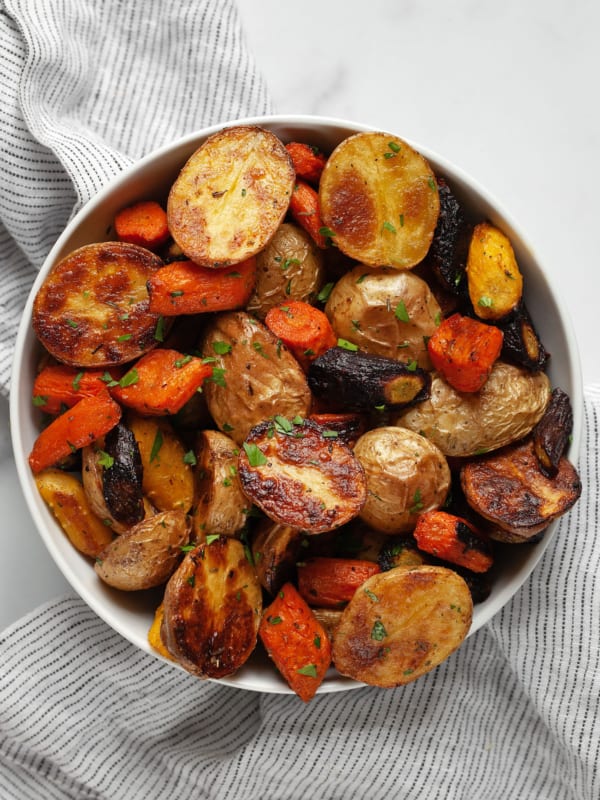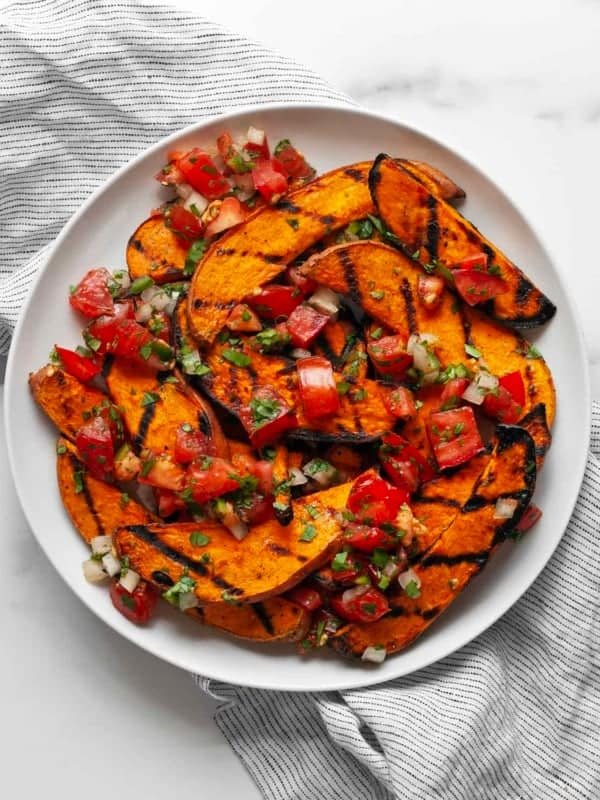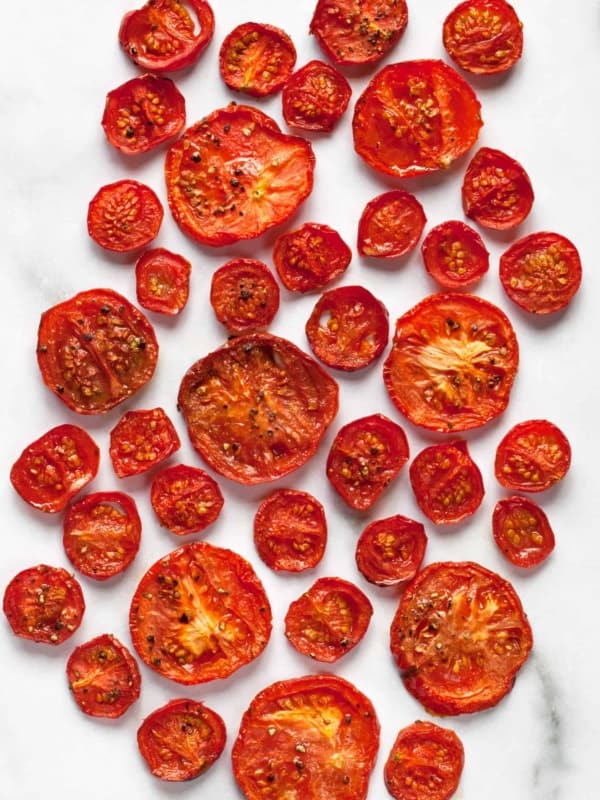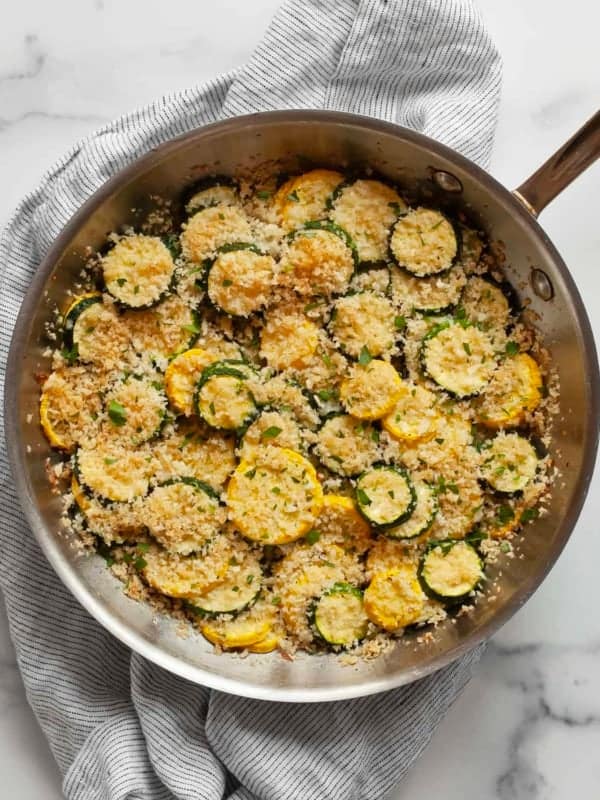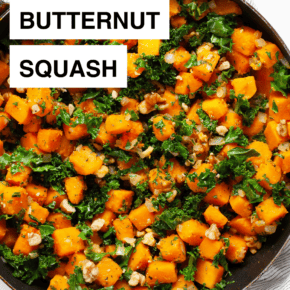Sautéed Butternut Squash
on Oct 05, 2020, Updated Nov 13, 2023
This post may contain affiliate links. Please read our disclosure policy.
Before you go ahead and roast winter squash, remember that you can cook it on the stove too. For this easy sautéed butternut squash, I sauté it with onions, garlic, dried spices and chopped kale. I also stir in toasted walnuts. It’s a simple side dish that’s more complete than just cooked squash on its own. The recipe has only 10 ingredients and takes about 20 minutes to make.
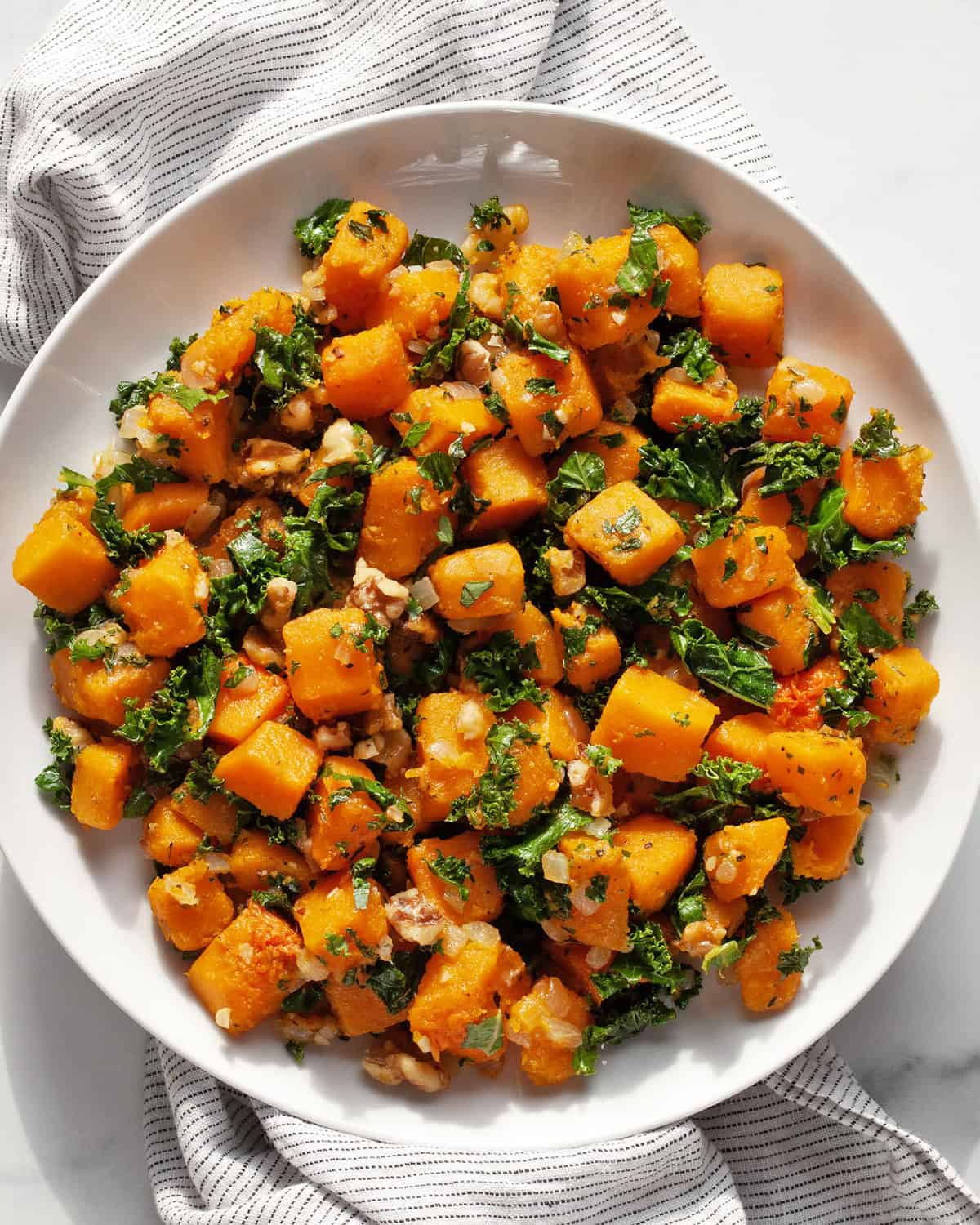
Table of Contents
Why You’ll Love This Recipe
It’s helpful to have stovetop side dishes that don’t take up precious oven space. This is especially true for holiday meals like Thanksgiving, but it’s handy for weeknights too. During fall and winter, often it seems like everything requires the oven, which can make it tricky to time the main dish and sides being ready at the same time.
Sautéing butternut squash is quicker than roasting. Depending what you are serving with it, I like the variety that sautéing gives you. As mentioned, you don’t always have to roast squash. You have options.
Cooking squash in a skillet makes it easy to add seasonings, onions, garlic and kale. They add fantastic flavor, and of course, you boost the nutrition of your side dish. It’s a win-win.
This side dish recipe is gluten free and vegan, so it will work for all sorts of dietary preferences. There is no butter. It relies on garlic and dried seasonings for flavor.
The Ingredients
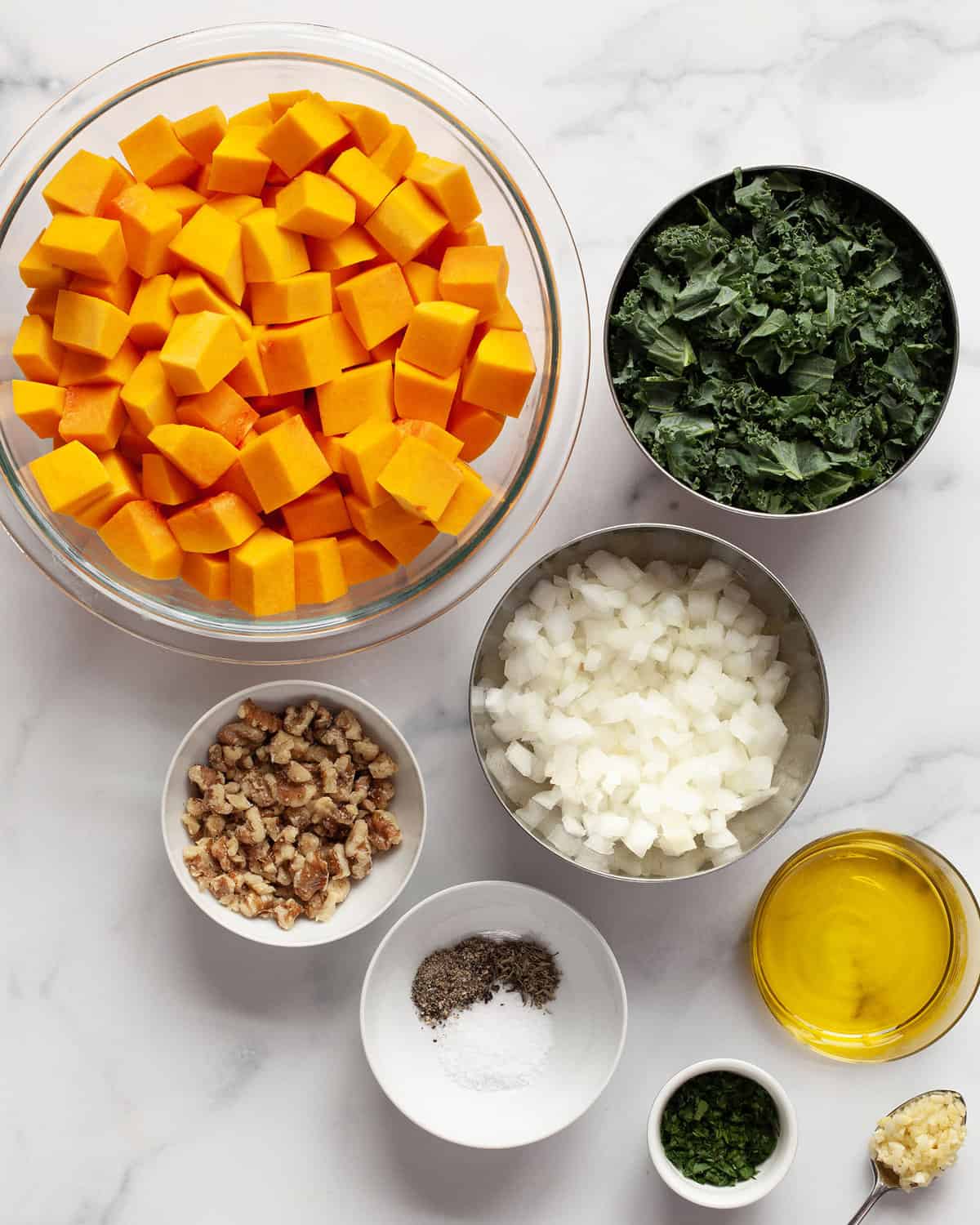
This is what you need:
- Butternut squash: The recipe calls for a whole butternut squash, about 3 pounds, peeled and cut into 1/2-inch cubes. Choose one that doesn’t have any dents, bruises or soft spots. You can buy squash that’s already cut if you are looking for a shortcut.
- Kale: Curly kale or lacinato kale will work.
- Onions: You can use either a white onion or yellow onion.
- Garlic: Along with the spices, I sauté 2 minced garlic cloves.
- Dried spices: I season the squash with dried thyme, salt and black pepper.
- Walnuts: For the best taste, toast the nuts on a sheet pan for 5-7 minutes at 350 degrees F. I like to toast an entire batch of nuts at once, so then I have them ready in my pantry for salads and other recipes. You can substitute with chopped almonds or pecans.
- Parsley: I finish the squash with chopped fresh herbs. Instead of fresh parsley, you can swap with minced chives or use a mix of both.
- Olive oil: I prefer high quality extra virgin olive oil.
Optional Additions
You can add one or more of the following:
- Parmesan cheese: When you stir in the nuts, add grated Parmesan.
- Maple syrup or honey can sweeten sautéed squash. Stir in 1 tablespoon with the garlic and spices. This gives you a balance of sweet and savory.
- Red pepper flakes: For a little heat, add pinch of red pepper flakes.
How To Make Sautéed Butternut Squash
1. Sauté the squash. Heat the oil in a big skillet over medium heat. Then add the squash cubes, stirring frequently, until they become tender, about 10 minutes.
2. Add the chopped onions. Sauté them until they are soft and translucent, about 4-5 minutes. Again, you want to keep stirring to distribute the heat and ingredients in the pan.
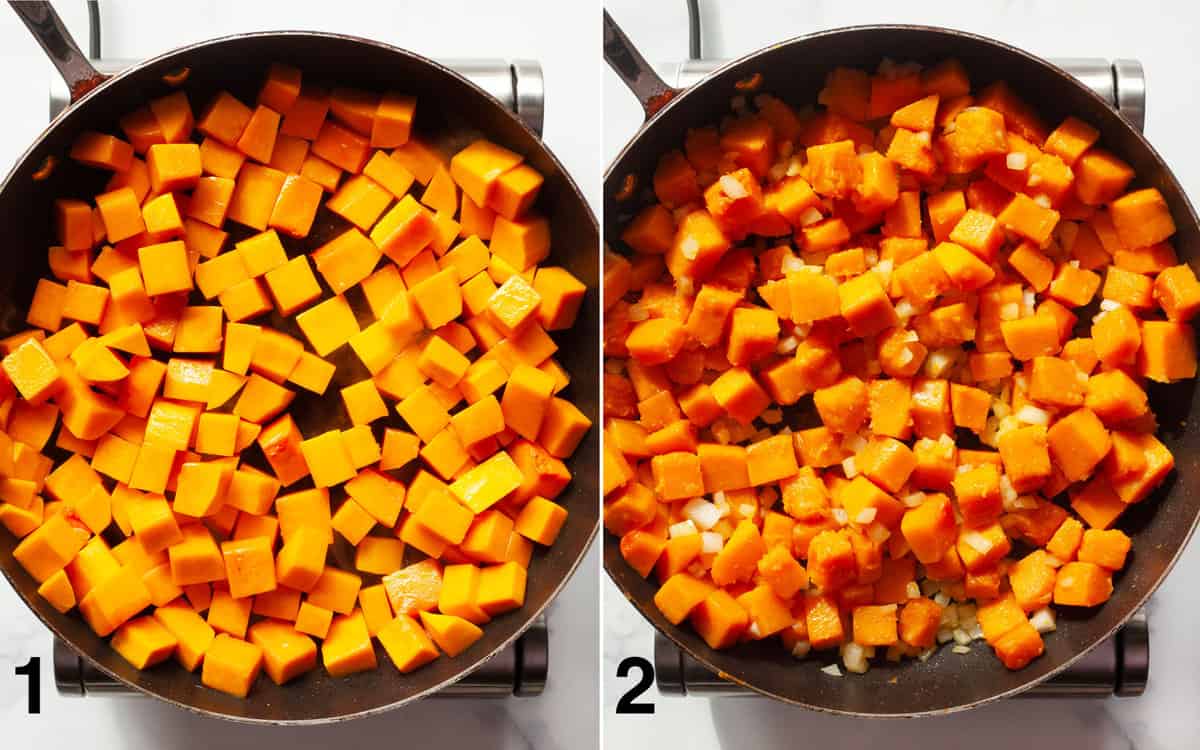
3. Stir in the garlic, thyme, salt and pepper. Give the squash and onions a minute to become fragrant.
4. Add the kale. It will soften in a few minutes. Then stir in the walnuts and parsley.
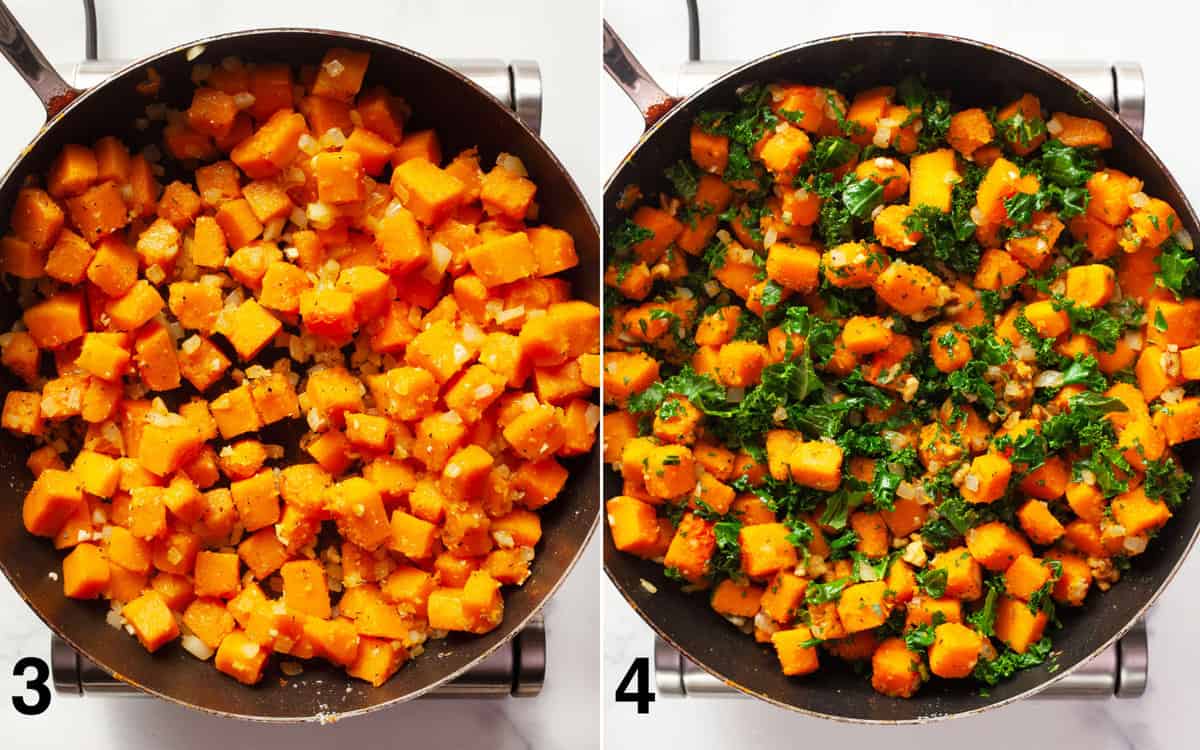
Serving
Sautéed squash is best eaten warm. I don’t recommend cooking it in advance. Again, take advantage of the fact that this recipe is cooked on the stove and not in the oven. Then you can do the sautéing while the main dish is in the oven.
This is a good choice for a Thanksgiving or Christmas side to go with roasted turkey. And don’t forget it for weeknight dinners with roasted chicken or salmon.
Storage & Leftovers
You can keep leftovers in an airtight container in the refrigerator up 3 days. You can warm them with a little oil in a skillet on the stove over medium heat. The kale will be softer than when you first sautéed it. You can add more chopped kale if you want. You can also stir warmed leftovers into cooked grains or pasta.
Recipe Tips
Do your best to cut the squash into cubes that are the same size. This will help them cook in the same amount of time. First, peel it with a vegetable peeler and then use a sharp knife to cut it.
If possible, sauté the squash in a non-stick skillet. Even though you heat oil in the pan before you cook the squash, it will reduce the potential for sticking if it’s non-stick.
Taste the squash for doneness and seasonings. Be careful because it will be hot. Take a bite of the squash to make sure it doesn’t need a couple minutes more time to be fork tender and that it doesn’t need more salt and pepper.
Recipe FAQs
My preference is minced fresh garlic cloves, but you can add 1/8-1/4 teaspoon garlic powder. Dried will give you a more intense garlic flavor.
The peel is edible, but for the most consistent doneness, you should peel it when you are prepping the squash to sauté it.
No. If you aren’t a fan of kale, you can leave it out. Just know that it will reduce the yield.
The best way to freeze cooked squash is to puree it. Since this recipe has onions and kale in it that would not make it ideal for pureeing, so I don’t recommend freezing it.
More Butternut Squash Recipes
Baked Butternut Squash Risotto
Fall Harvest Salad
Roasted Butternut Squash Pasta
Butternut Squash Apple Soup
Roasted Butternut Squash Broccoli Orzo
Sautéed Butternut Squash
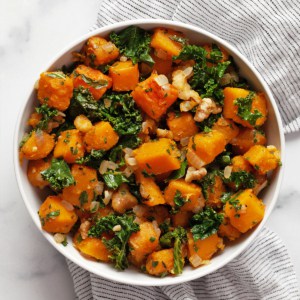
Ingredients
- 1 tablespoon olive oil
- 1 butternut squash, about 3 pounds, peeled, deseeded and cut into 1/2-inch cubes
- 1 small onion, roughly chopped
- 2 garlic cloves, minced
- 1/4 teaspoon dried thyme
- 1 teaspoon kosher salt
- 1/2 teaspoon black pepper
- 1-1/2 cups chopped kale
- 1/4 cup chopped toasted walnuts
- 1 teaspoon chopped parsley
Instructions
- Heat the olive oil over medium heat and sauté the squash. Stir frequently and give the squash about 10-12 minutes to become tender.
- Add the chopped onions. Sauté them until they are soft and translucent, about 4-5 minutes.
- Stir in the garlic, thyme, salt and pepper. They will make the squash and onions fragrant in 1 minute.
- Add the kale, letting it soften, about 2-3 minutes.
- Stir in the walnuts and parsley.
Video
Notes
-
- Parmesan cheese: When you stir in the nuts, add grated Parmesan.
-
- Maple syrup or honey: To sweeten the squash, stir in 1 tablespoon with the garlic and spices. This gives you a balance of sweet and savory.
-
- Red pepper flakes: For a little heat, add pinch of red pepper flakes.
Nutrition
Nutrition information is automatically calculated, so should only be used as an approximation.

